Warszawa II (19 page)
Authors: Norbert Bacyk
The commander of the 9th Army had no illusions that the cessation of attacks against Praga on September 3 was anything other than for the purpose of regrouping Soviet combat forces in preparation for new assaults. His immediate superior shared this view and reported the following to the OKH on September 6:
“In the 9th Army's zone the enemy till now has limited itself to small-scale, localised combat activities inside the 1st DKaw [â¦]. When the enemy is now strengthening their combat forces, it is clear to the 73rd DP (Panzer Division?) that this enemy, beyond any conceivable circumstance or doubt, has not given up its plans to attack Warsaw's bridge area.”
Despite this, on September 8 General Reinhardt gave orders to von Vormann to transfer command of the XXXXVI Panzer-Corps, together with the rest of the 19th Panzer-Division at Magnuszew, to the 2nd Army. General Lüttwitz's staff would coordinate the counter-attack against the bridgehead at PuÅtusk and the time-point was set for September 13. When the panzer corps' officers set off on September 9, the 8th Army-Corps again overtook command of the forces blockading the mouth of the Pilica, while the area between Warsaw and Góra Kalwaria was taken over by the improvised Gruppe “Sickenius” (General Sickenius' staff from the 391st Sicherungs-Division z.b.V and the Hungarian 5th Reserve Division). The 19th Panzer-Division's columns also set off towards the north during the evening of September 9. General Källner's subordinates still had no idea that instead of marching towards Pultusk, they would wind up in the middle of the battle for Praga.
A Soviet reconnaissance detachment using American amphibious vehicles on a scouting mission across one of Poland's many rivers. (Leandoer & Ekholm archive)
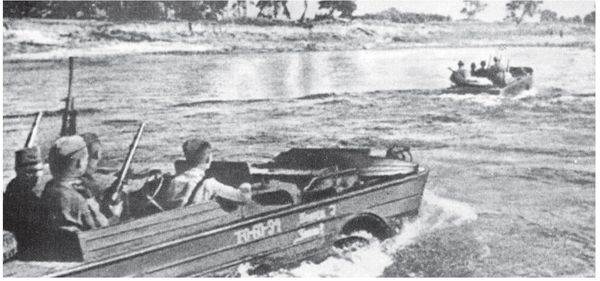
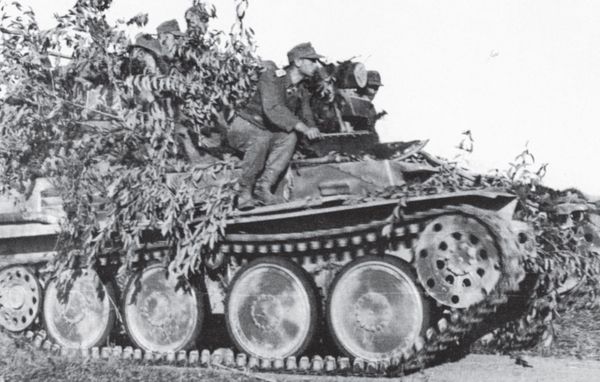
A well-camouflaged Sd Kfz 138 ausf M “Grille” from the 19th Panzer-Division redeploying toward the enemy northeast of Warsaw, August 1944. (Leandoer & Ekholm archive)
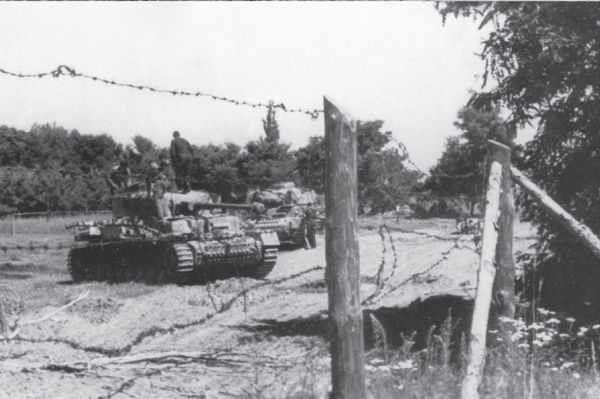
Two PzKpfw IV ausf H from the 19th Panzer-Division just east of Warsaw in the beginning of September 1944. (Leandoer & Ekholm archive)
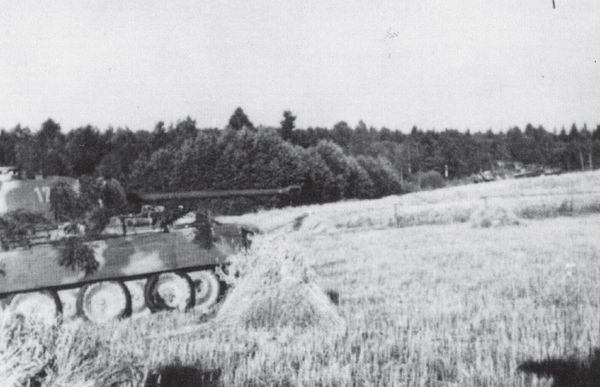
A Panther from the first company in Panzer-Regiment 27/19th Panzer-Division. Note that it is positioned at the bottom of a slope; also note that it is battle-ready, August 1944, northeast of Warsaw. (Leandoer & Ekholm archive)
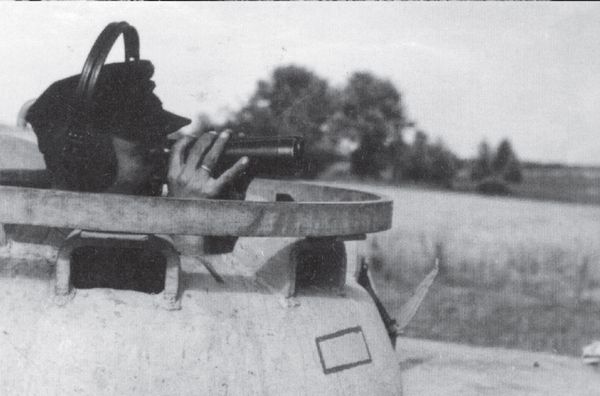
Perhaps a Panther commander from the same company at the same place? Hardly exposed, he rises just high enough within his tower to scout the terrain through his binoculars, in August, northeast of Warsaw. (Leandoer & Ekholm archive)
September 18 â 19, 1944
T
hroughout the month of August, Stalin, as has already been mentioned, deliberately held back the storming of Praga since it clearly risked hindering the Germans from pacifying Warsaw, despite the unspeakable brutality of their methods. Nor did he, notably enough, make a secret of this reasoning which he wrote of in his letters to the leaders of the western powers. The dictator's wording concerning “the public distancing from the Warsaw-disturbance” â together with his order concerning the denial of allied landing rights â was an openly hostile policy towards the Uprising. However, such a clearly spelled out perspective, which also served as clear evidence of his capacity for grim and mercilessly cold calculation, came to provoke strong exception in the western press. Political relations with Great Britain became extremely strained and the USA's ambassador in Moscow talked about his
“serious concerns regarding the Soviet government's position.”
In this sensitive atmosphere, Stalin consulted with the officers at headquarters toward the end of August about near-term operational plans. STAVKA at this time had its attention primarily focused on the Romanian front and the planned new offensive in the Baltic States which was to be carried out in the very near future. Zjukov asserted that the 1st Ukrainian Front and the 1st Belorussian Front had already exhausted their resources with respect to offensive warfare, which was also reflected in the order dated August 29, directing a tactical shift to defensive warfare and consolidation. This order, in practice, merely sanctioned the prevailing situation. Zjukov's order encompassed not only the right flank in Marshal Rokossovskij's front, which should make every strain necessary to reach the Narew and take the well defended bridgeheads on its west bank (this was the purpose of the fighting between Wyszków and Radzymin). According to the commander's representative, one of the considerations behind this operation was the necessity of also storming Praga itself, primarily to even out the front and improve the tactical connection between the flanks of Marshal Rokossovsk's forces. STAVKA already possessed
information concerning the stubborn defence mounted by the IV SS-Panzer-Corps and consequently wanted to eliminate any possible threat from the enemy panzer corps. And lastly, the prospect of success for the fighting along the Narew was partly dependent on the continued presence of the German's 9th Army along the WisÅa â a factor that materially hindered it from being used as a support force to the 2nd Army,
Stalin approved Zjukov's plans. Marshal Rokosovskij, after regrouping his troops, would storm Praga, clear the area surrounding the Narew's entry into the WisÅa, from this join to Modlin, and then shift from attack to defence of the river's eastern bank. Help to the crumbling uprising was not a consideration in the planning. The attack, scheduled to commence September 10, was to be carried out by the 70th and 47th Armies, along with the 8th Guards Tank Corps. With regard to the 28th Army, the decision was made that it would no longer be a part of the 1st Belorussian Front. Instead, it would be moved north to join the planned fighting in East Prussia. The 28th Army was finally relieved on September 8, and left the outskirts of Warsaw as late as the evening prior to the storming of Praga.
On September 4, the British War Cabinet communicated its special decision to Stalin, where, among other items, it read::
Â
“The War Cabinet wishes to inform the Soviet government that public opinion in this country is deeply outraged over the events taking place in Warsaw and the terrible suffering of the Poles [â¦] The British people cannot understand the motive for not sending relief with aid and materials to the Poles of Warsaw. The fact that this material could not be sent because You refused to grant Your permission for American aircraft to land on airfields within Russian areas is on the threshold of becoming a matter of general public knowledge. [...] The War Cabinet, itself, cannot understand Your government's refusal [...] Your government's actions in hindering aid assistance, we regard as not being consistent with the spirit of cooperation required between allies, in which You, as do we, today, and in the future, place such a considerable measure of weight.”
In diplomatic terms this was a serious warning, a threat of sanctions. Stalin was, of course, dependent on military aid from the west, particularly with regard to modern industrial equipment. He had also approved the original concept of storming Praga and, at first, had ordered the reinforcement of the 1st Infantry Division's 47th Polish Army (according to the operational order issued on September 5) and then, on September 11, the withdrawal of the entire 1st Polish Volunteer Army from Magnuszew and its re-deployment, in the 47th Army's wake, towards Warsaw. The dictator sought in this way to show his goodwill towards the Uprising, and by having engaged the use of Polish troops even indicate that the capital should indeed be freed by the Poles themselves. On September 10, he also withdrew his order not to grant allied planes landing rights on Soviet airfields, and ordered the Soviet Air Force to take complete control over Warsaw's airspace. On September 13 1944, the first airborne weapon delivery was parachute-dropped to the resistance men.
A propaganda photo which depicts Polish/Soviet comradeship, Warsaw-Praga, September 1944. (WAF)
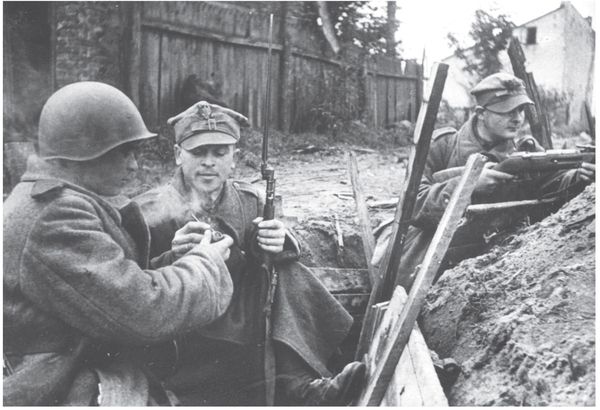
On September 9, Marshal Rokossovskij received reports from Generals Popov and Gusiev that their armies were ready to conduct further attacks on Warsaw. On the same day, the Soviet bomber wing launched heavy raids on positions held by the 73rd Infantry-Division and the Hungarian 1st Cavalry Division. Intensive reconnaissance of German positions in the IV SS-Panzer-Corps area was carried out, with the intent of disorientating the opposition with regard to the main direction of attack. This succeeded because, even as late as September 7, von Vormann reported that “ â an attack is expected from the 70th and 28th Armies against the 9th Army's left flank, as well as from the 47th Army against Praga.” The German High Command thus perceived the greatest threat to be in the north, although the 8th Guards Tank Army on September 6 was re-deployed from the 70th to the 47th Army. It wasn't until September 9 that German reconnaissance flights observed this Soviet troop movement and then noted it in reports. The following day the offensive was launched.
Early September 10, the two sides were deployed as follows. On the German side along the Zbytki â MiÄdzylesie â Stara MiÅosna â WesoÅa line stood the 73rd Infantry-Division: Between WesoÅa and Zielonka stood the Hungarian 1st Cavalry Division: In the forests between Zielonka and SÅupno, the 3rd SS-Panzer-Division “Totenkopf” was stationed, and in the terrain stretching from the village of Sieraków to Rynia, the 5th SS-Panzer-Division “Wiking” â less SS-Panzer-Regiment “Wiking.”
Polish infantry attack with support from Soviet T-34/85 tanks, August â September 1944. (WAF)
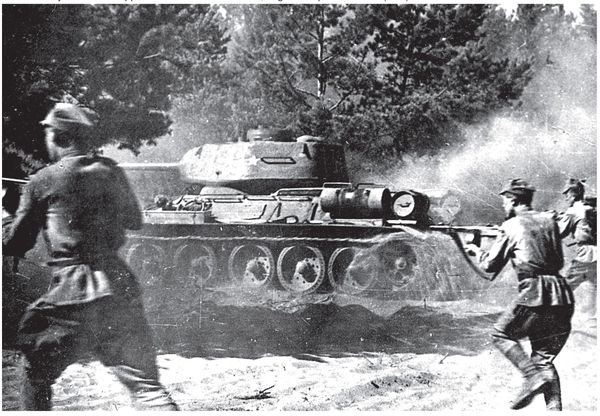
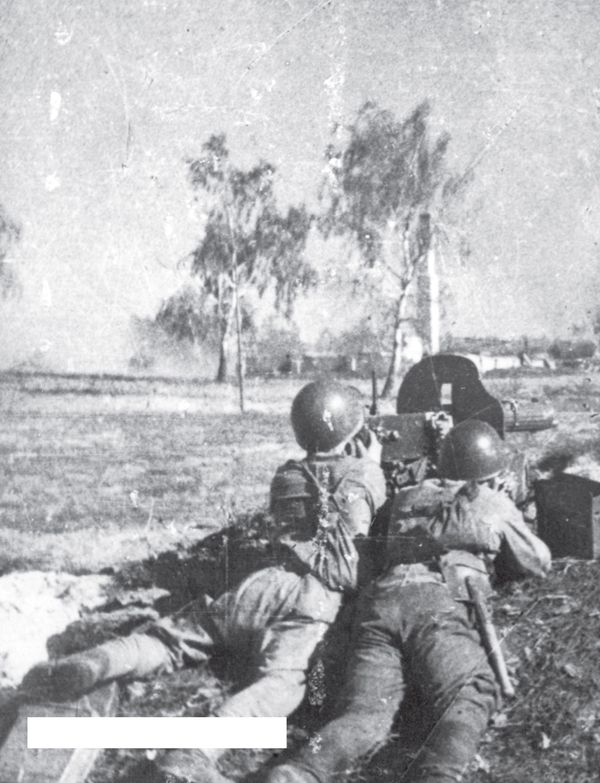
A Polish Maksim machinegun (model 1910) being fired from a 1st Infantry Division position at Anin in September 1944. (WAF)
The list of all the units comprising the IV SS-Panzer-Corps included:
- Eisenbahn Panzerzug Regiment 1
- The II and IV Batteries from the 102nd Werfer-Regiment (from the 300th Festung-Werfer-Brigade),
- Kommando 9th Army Sturm-Battalion (except the 1st Company)
- The 9th and 421st Festung-Pionier-Battalions
- The 2nd and 4th Companies, 737th Festung-Pionier-Bataillon
- The 2nd Company, 5th Festung-Pionier-Ausbildungs-Bataillon
- The 500th SS-Jäger-Battalion
- The 5 II, 1 VI, 2 VI and 4 II Flak-Festungs-Companies
- The 23rd Festungs-MG-Battalion
- The 73rd Infanterie-Division (except the 73rd Machinegun Battalion and parts of the 1886th Infantry Regiment) along with the subordinate 745th Panzer-Jäger-Abteilung, 2./475 Panzer-Jäger-Artillerie-Abteilung
- The 1st The Royal Hungarian Cavalry Division and the unit subordinated to them, schwere Artillerie-Abteilung 154
- The 3rd SS-Panzer-Division “Totenkopf” and
- The 5th SS-Panzer-Division “Wiking” along with its subordinated units: the 1145th Grenadier-Regiment, the 560th Infanterie-Abteilung z.b.V as well as the 1405th Infanterie-Festungs-Bataillon.
Their opposition included: the 47th Army, the 70th Army, the 8th Guards Tank Corps (the 58th Guards Tank Brigade, the 59th Guards Tank Brigade, the 60th Guards Tank Brigade, the 28th Guards Mechanised Brigade). The complement and operational positioning of the 47th Army was as follows: the remnants of the 105th Reserve Brigade, as well as the 175th Rifle Division, the 1st Tadeusz KoÅciuszko-Infantry Division, the 76th Rifle Division, a Rifle Regiment from the 60th Rifle Division (from the 125th Rifle Corps) in the area of MiÄdzylesie-Stara MiÅosna. As a reserve for the 125th Rifle Corps, in the vicinity of Michalin stood the remnants of the 60th Rifle Division and the 143rd Rifle Division. The 234th Rifle Division and the 185th Rifle Division were located between Stara MiÅosna and Ossów
The WoÅomin region was manned by the 129th Rifle Corps which encompassed the 260th, the 132nd and the 328th Rifle Divisions. In the area from SÅupno to the Narew we find the 70th Army, with combat forces from the 114th Rifle Corps in the area of Radzymin (160th, 165th and 413th Rifle Divisions) and the 96th Rifle Corps (the 1st Rifle Division, the 38th Guards Rifle Division & the 76th Rifle Corps).
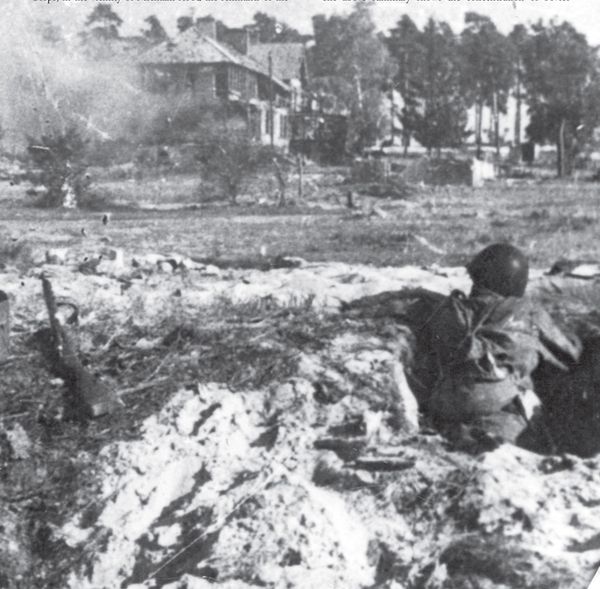
The above summary shows the concentration of Soviet
forces in the two most important compass points from which to launch attacks. The first is the southern location around Anin where the following forces were assembled: five infantry divisions, a tank corps, a reserve brigade, and a reinforced artillery. The other was between Wólka RadzymiÅska and SÅupno. Concentrated there, within very small bounds, was the 70th Army's 114th Rifle Corps. The Soviet command also planned during the course of following days to send the 1st Polish Volunteer Army to fight in the southern sector.